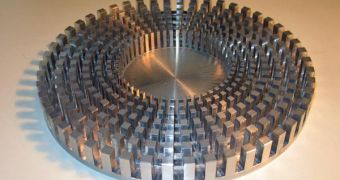Scientists have built a device that, if applied to larger scales, would allow ocean waves, even those as big as a tsunami, to travel through a large structure (an offshore platform or even an island) without the waves or the respective structure being altered at all.
Invisibility doesn't just refer to light and vision, as common acceptance would have it. The past success registered by steering light around the two dimensional objects encouraged researchers to look for the application of similar effects to other environments, such as water. In this case, it implies that water would pass by an existing structure as if it wasn't there, therefore helping them to protect giant structures from the destructive force of tsunami-like waves.
The first successful attempt to build an invisible cloak was recorded in 2006, when microwaves were guided around a tiny copper ring as if it didn't even exist. Since late 2007, there has also been some progress on handling the more difficult matter of cloaking three dimensional items, but there's still much work to be done in that regard. Stefan Enoch from the Fresnel Institute in Marseille, France, is keen on applying the basic principles of invisibility to the fundamentally 2D ocean waves for protective purposes.
His team of researchers has managed to build up a small device to be tested in a wave tank. It is 10 cm (nearly 4 inches) across, and it's provided with a large number of concentric rings of stern pillars shaped as a labyrinth of concentric radial passages. Although it may appear that water could easily gain access directly to the center, in fact it is prevented to do so by the pillars which, instead, force the waves to travel through the concentric corridors. As a member of Enoch's team, Sebastian Guenneau from the University of Liverpool, UK, explains, “Basically, the cloak behaves like a whirlpool. The further you go into the whirlpool, the faster you rotate”.
The narrower passages close to the middle of the prototype device cause the forces in the waves to increase, as well as the rate at which water spins. After water bypasses the center, it is flushed out through the similar radial corridors in the opposite way, reversing the process. “If you imagine water entering the cloak from the north, some leaves the cloak to the east, and some leaves to the west, but most is thrown out at the south,” adds Guenneau. After exiting the device, water looks like it hadn't been disturbed at all.
Ulf Leonhardt from the University of St Andrews, UK, is impressed with the finding, “I think that this is a great idea with much potential. One could really imagine protecting coastlines by arrays of cleverly designed concrete poles”. This calls for the usage of metamaterials, materials that don't rely on internal composition but on structure and placement. Still the costs of such projects deter even Guenneau. “It's crazy - maybe only people in Dubai could do this,” he states, thinking of the fantastic artificial islands of the region. But he still considers the idea of protecting the offshore oil platforms.

 14 DAY TRIAL //
14 DAY TRIAL //